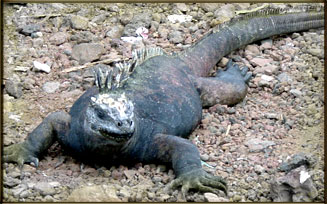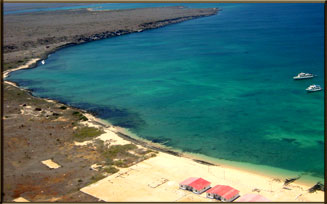
|

September
12, 2004
It’s a two-day trip to the Galapagos for nearly all
the participants to this “usable science” workshop,
and we’ve come from all over the world to converge in
Guayaquil, Ecuador’s largest city. Introductions and
shop talk start immediately and I find a good mix of different
backgrounds: social anthropology, meteorology, economics,
agriculture science, public health, biology, philosophy, oceanography,
climatology, hydrology, and environmental science. A shared
journey seems a great way to start a meeting and perhaps that
was the deliberate plan of the organizer, Michael Glantz (or
as everyone calls him, “Mickey”). All the participants
were handpicked by Mickey for their expertise, richness and
diversity of ideas, and ability to think across disciplines.
After
spending the night in Guayaquil, we board another flight to
the Galapagos. From the air, this group of islands appears
dark and bare of vegetation. On the ground on Baltra Island,
we see our first iguana and some scattered prickly pear cacti
(
Opuntia echiosis
). A short boat ride takes us to
Santa Cruz Island, and a bus delivers us to our destination:
Puerto Ayora. With about 10,000 residents, it’s one
of the largest towns in the Galapagos.
We arrive
to scout out the meeting location, the Charles Darwin Research
Station just outside of town. The station was established
in 1959, the same year that Ecuador placed the Galapagos archipelago
under the protection of its national park system to commemorate
the 100th anniversary of the publication of
The Origin
of Species
. But we’re told by our liaison that
there’s a problem: We can’t meet at the research
station because Galapagos National Park employees were planning
to strike the next morning and shut down the research station
and park.
Of Fishermen, Sea Cucumbers and Politics
The park rangers were angry because the central government
in Ecuador had just fired the park director and were sending
in a replacement. I was told by Jose Luis Santos, an Ecuadorian
professor and co-organizer of the meeting, that this would
be the eighth director in the last year. The park employees
were tired of having their boss replaced every month or two
and were protesting the government’s appointment of
yet another new one. I asked Jose why the high turnover and
he said it was a political strategy to appease Ecuadorian
fishermen, who wanted rules for collecting in the park loosened.
What they are fighting over is the sea cucumber, a sausage-shaped
invertebrate highly prized in the Japanese market. The fishermen
want to collect year-round to keep their income flowing, but
park officials worry about the ecological damage such harvesting
would cause, and continue to enforce strict regulations. The
government, pressured by the fishermen and not wanting to
appear indifferent to their needs, reacts by firing the park
director. But each successive park director supports regulations,
so the cycle continues.
It’s
one of those seemingly intractable struggles between human
need and environmental peril, a subject we would return to
often during the course of the workshop; that is, once we
found a meeting place.
|





